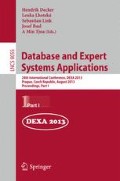Abstract
The design rationale behind the triplification of a relational database is a valuable information source, especially for the process of interlinking published triplesets. Indeed, studies show that the arbitrary use of the owl:sameAs property, without carrying context information regarding the triplesets to be linked, has jeopardized the reuse of the triplesets. This article therefore proposes the StdTrip+K process that integrates a design rationale approach with a triplification strategy. The process supports the reuse of standard RDF vocabularies recommended by W3C for publishing datasets and automatically collects the entire rationale behind the ontology design, using a specific vocabulary called Kuaba+W.
Access this chapter
Tax calculation will be finalised at checkout
Purchases are for personal use only
Preview
Unable to display preview. Download preview PDF.
References
Auer, S., Dietzold, S., Lehmann, J., Hellmann, S., Aumueller, D.: Triplify: light-weight linked data publication from relational databases. In: WWW 2009, pp. 621–630. ACM, New York (2009)
Bizer, C., Seaborne, A.: D2RQ-treating non-RDF databases as virtual RDF graphs. In: Proceedings of the 3rd International Semantic Web Conference, ISWC 2004 (2004)
Bizer, C., Heath, T., Berners-Lee, T.: Linked Data - The Story So Far. International Journal on Semantic Web and Information Systems (IJSWIS) 5(3), 1–22 (2009)
Cerbah, F.: Learning highly structured semantic repositories from relational databases: The RDBToOnto Tool. In: Bechhofer, S., Hauswirth, M., Hoffmann, J., Koubarakis, M. (eds.) ESWC 2008. LNCS, vol. 5021, pp. 777–781. Springer, Heidelberg (2008)
Cullot, N., Ghawi, R., Yétongnon, K.: DB2OWL: A Tool for Automatic Database-to-Ontology Mapping. In: SEBD, pp. 491–494 (2007)
Dividino, R., Schenk, S., Sizov, Staab, S.: Provenance, Trust, Explanations – and all that other Meta Knowledge. Künstliche Intelligenz KI 23(2), 24–30 (2009)
Erling, O., Mikhailov, I.: RDF support in the virtuoso DBMS. Networked Knowledge-Networked Media, 7–24 (2009)
Lee, J.: Design Rationale Systems: Understanding the Issues. IEEE Expert 12(13), 78–85 (1997)
Lee, J., Lai, K.: What’s in Design Rationale. Human-Comput. Interaction 6(3-4), 251–280 (1991)
Maclean, A., Young, R., Bellotti, V., Moran, T.: Questions, Options, and Criteria: Elements of Design Space Analysis. Human-Comput. Interaction 6(3-4), 201–250 (1991)
McGuinness, D., Harmelen, F.: OWL web ontology language – W3C Recommendation (2004), http://www.w3.org/TR/owl-features/ (retrieved February 2013)
Medeiros, A.P., Schwabe, D.: Kuaba approach: Integrating formal semantics and design rationale representation to support design reuse. Artificial Intelligence for Engineering Design, Analysis and Manufacturing 22, 399–419 (2008)
Prud’hommeaux, E., Hausenblas, M.: Use cases and requirements for mapping relational databases to rdf (2010), http://www.w3.org/TR/rdb2rdf-ucr/ (retrieved November 27, 2012)
Salas, P., Viterbo, J., Breitman, K., Casanova, M.A.: StdTrip: Promoting the Reuse of Standard Vocabularies in Open Government Data. In: Wood, D. (ed.) Linking Government Data, pp. 113–134. Springer (2011)
Sequeda, J., Depena, R., Miranker: Ultrawrap: Using SQL views for RDB2RDF. In: Proceedings of International Semantic Web Conference. ISWC 2009 (2009)
Author information
Authors and Affiliations
Editor information
Editors and Affiliations
Rights and permissions
Copyright information
© 2013 Springer-Verlag Berlin Heidelberg
About this paper
Cite this paper
Berardi, R., Breitman, K., Casanova, M.A., Lopes, G.R., de Medeiros, A.P. (2013). StdTrip+K: Design Rationale in the RDB-to-RDF Process. In: Decker, H., Lhotská, L., Link, S., Basl, J., Tjoa, A.M. (eds) Database and Expert Systems Applications. DEXA 2013. Lecture Notes in Computer Science, vol 8055. Springer, Berlin, Heidelberg. https://doi.org/10.1007/978-3-642-40285-2_26
Download citation
DOI: https://doi.org/10.1007/978-3-642-40285-2_26
Publisher Name: Springer, Berlin, Heidelberg
Print ISBN: 978-3-642-40284-5
Online ISBN: 978-3-642-40285-2
eBook Packages: Computer ScienceComputer Science (R0)

